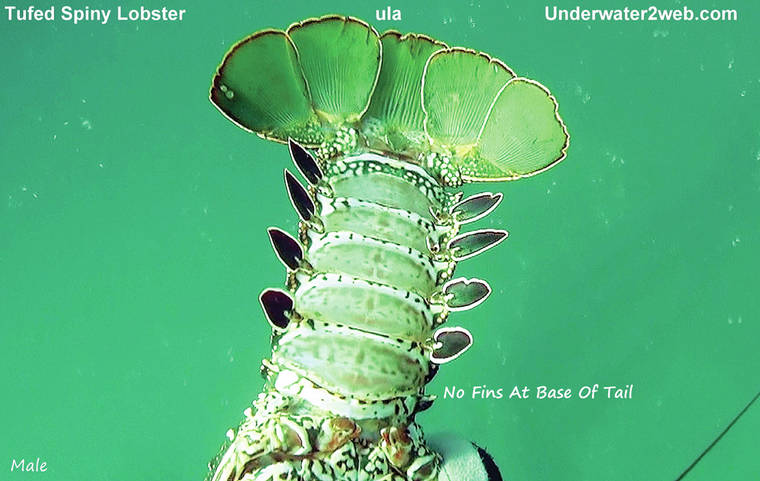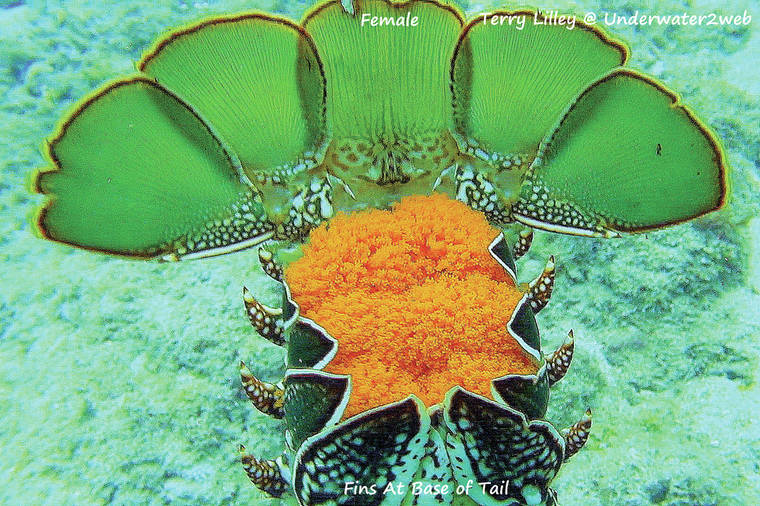There are many rules and regulations about catching lobsters for food, depending what part of the world you live in. Many countries and the state of Hawai‘i have lobster seasons, and also forbid the taking of female lobsters. The problem is most people do not know how to sex a lobster!
I have been catching lobsters since I was a kid, and lobsters are one of the most-sustainable seafood species on Earth, according to a very-detailed study done by Monterey Bay Aquarium.
Lobsters live in most of the oceans on earth, in cold and warm water, and they live in areas that make them hard to over-collect. Here in Hawai‘i many of the lobsters live right on the reef under the big surf, and are active at night, so they are almost impossible to catch. Lobsters eat limu (seaweed), and also just about anything dead, so they have a lot of food where they live out on the reef. In restaurants you often see Maine lobsters served, and that is because they catch that species in traps. But most lobsters worldwide cannot be trapped due to the surf and currents where they live.
Sexing a lobster is easy once you see the difference between the fin structure of the male and female on the underside of the tail. Female lobsters have a row of fins called swimmerets on the base of the underside of the tail. The males do not have this row of fins.
The female fins along the side of the tail are twice the size of the males. The females have these extra sets of swimmerets to hold onto their eggs. A female lobster can have up to 100,000 eggs every two years. Once the eggs have been fertilized by a male, the female will carry her eggs from nine to 12 months, until they hatch. When the eggs are newly laid they are bright orange, but after they are fertilized they turn a dark orange or brown color. Here in Hawai‘i I have seen many female lobsters with eggs year round, so there is not really a breeding season.
When the eggs are ready to hatch, the female releases them into the water, and they hatch out into the larval stage that is about the size of a mosquito. These larvae float around in the currents for over a month before they settle down onto the seafloor and start to grow. These baby lobsters may float a long distance after hatching, and new research is showing they may even float between islands on surface currents driven by the wind. It is possible that lobster hatched on Kaua‘i may end up all the way out at Ni‘ihau and, hopefully, DNA testing will soon give us some interesting information about our lobster populations!
The baby lobsters grow quickly, and they usually shed their entire outer shell once a year in one large piece.
People often find the empty outer shells on the beach and think it is a dead lobster, but if the shell is hollow inside it is just a shedding. As the lobsters grow to adults in five to seven years they may shed once every two years. And they can live up to 100 years old!
You can see our Hawaiian lobster species in action in the underwater educational movies at underwater2web.com. I am doing a special movie about lobsters worldwide, called “Lobsters, From The Reef To The Dinner Plate.”
•••
Terry Lilley is a marine biologist living in Hanalei. He is co-founder of Reef Guardians Hawaii, a nonprofit on a mission to provide education and resources to protect the coral reef. To donate to Reef Guardians Hawai‘i go to reefguardianshawaii.org.




What if the lobster feels that it was born the wrong gender? How do we ask the lobster if they identify as a female even if they are biologically a male?
Thank you. This helps. I hardly eat lobsters. About the only thing close to lobsters are shrimps. I eat those at Panda Express.